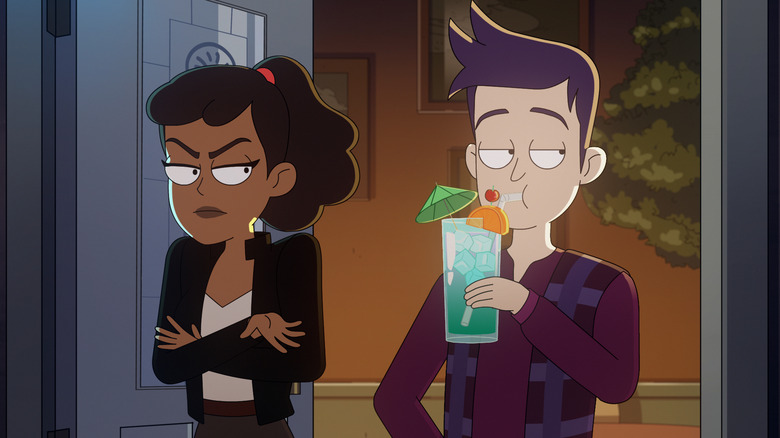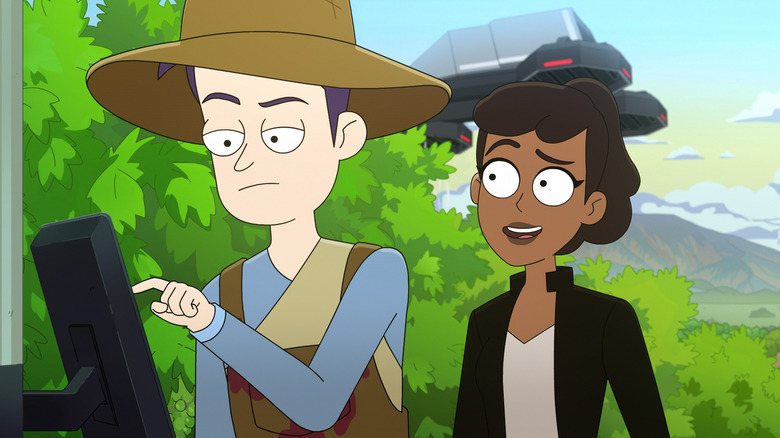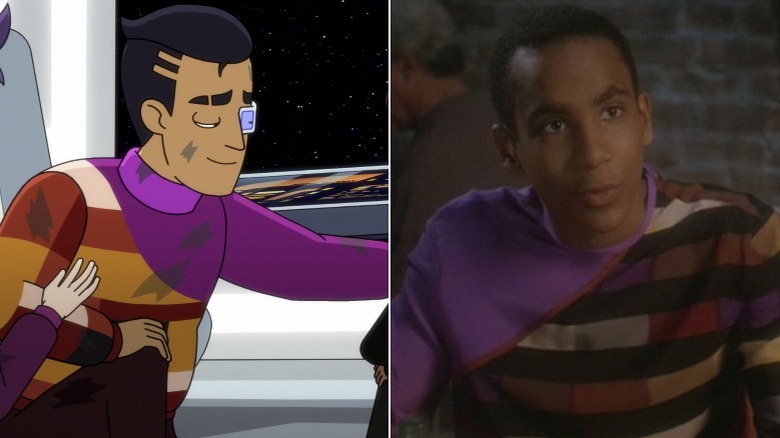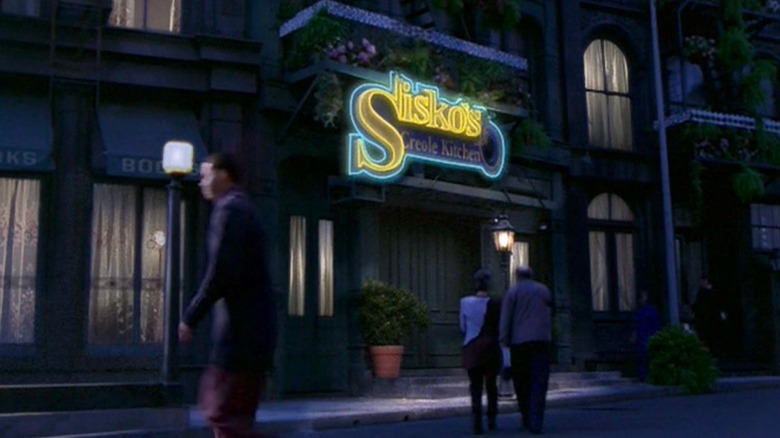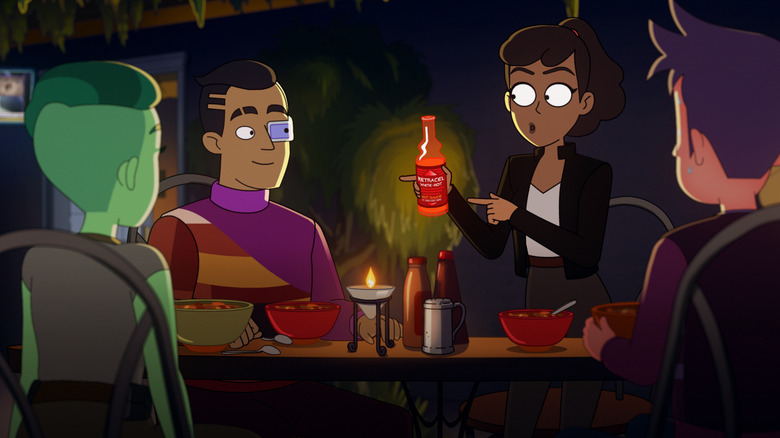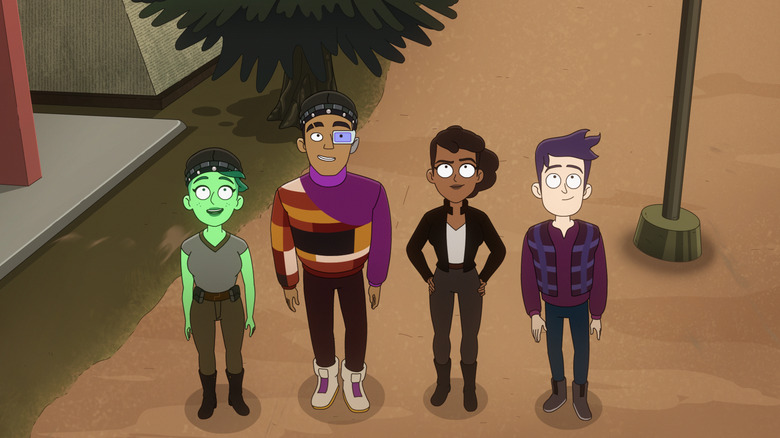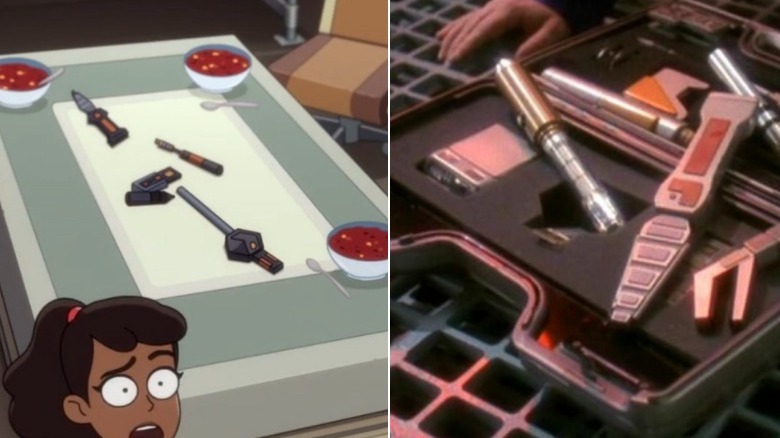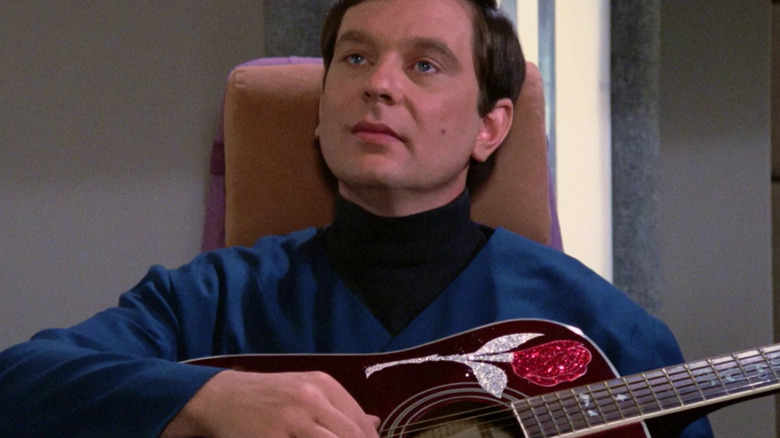The 7 Best Easter Eggs And References In Star Trek: Lower Decks Season 3, Episode 1
The premiere of "Star Trek: Lower Decks" season 3 arrived on Paramount+ today, which is exciting twofold for Trekkies. Not only is one of the better "Trek" shows back, but "Lower Decks" in particular gives detail-obsessed nerds a chance to take out their notepads and go reference hunting. The "Lower Decks" writers clearly know "Star Trek" quite well, and their references from previous episodes run from the obvious to the downright oblique. One needs to look closely to see some of the clever in-jokes snuck into the background.
These kinds of references are cute, yes, but it's worth noting that callbacks and canonical mapping have long been a "Star Trek" birthright. In terms of sci-fi TV, the notion of a larger, expanded universe that is operating somewhere far beyond the events of the central show — a universe that can be periodically visited — is something that "Star Trek" helped pioneer. Between "Star Trek" and "Doctor Who," the notion of pop culture TV canon was essentially born.
(You literature nerds can stop writing in angry letters about how Honoré de Balzac was inventing a literary version of interconnected supernarratives with his "La Comédie Humaine" back in 1829. We all know that.)
That said, let us trek into "Grounded," the premiere episode of "Lower Decks," season three, and see what fun references we can spot.
Boimler's vinyard
The premise of "Grounded" is that the U.S.S. Cerritos is currently under impound after Captain Freeman (Dawnn Lewis) was accused of an act of terrorism. The four main ensigns of "Lower Decks" find themselves back on Earth, tending to their individual concerns. Rutherford (Eugene Cordero) and Tendi (Noël Wells) are taking the opportunity to catch up on Earth tourist spots, Mariner (Tawny Newsome) is determined to prove that her captain, also her mother, is innocent, and Boimler (Jack Quaid) has returned to his family vineyard to tend to the grapes. But the Boimler family does not make wine. The Boimler family makes raisins.
Boimler being found on a vineyard, wearing a large straw sunhat no less, is a direct parallel to Captain Picard and his frequent visitations to the Picard family vineyard, first seen in the "Star Trek: The Next Generation" episode "Family" (October 1, 1990). The same vineyard would be the opening location of "All Good Things..." (May 23, 1994), the final episode of "The Next Generation," as well as Picard's eventual home in "Star Trek: Picard." Because of Picard, Boimler's presence on a vineyard feels natural and expected; this is simply what "Star Trek" characters do on their time off. They tend to the grapes.
Rutherford's sweater
Trekkies, perhaps more than other fandoms, are openly willing to point out when their beloved object of affection does something wrong. The bungling of way-too-slow-walked queer representation has always been a sticking point on "Trek," as has notably bad episodes; no Trekkie, however devout, will leap to the defense of the notorious "Spock's Brain," William Shatner's "Star Trek V: The Final Frontier," or the "Star Trek: Deep Space Nine" episode "Profit and Lace."
One of the more embarrassing details of "Trek," however, has to be the weird fashions worn by civilians on Deep Space Nine. The costumes, designed by Robert Blackman, featured bizarre puffy accents, weird colors, chrome patches, and other ugly accoutrements that looks like ... well, they look like multiple alien fashion trends haphazardly mashed together, so perhaps it was completely appropriate. Regardless, one must feel sorry for actor Cirroc Lofton, as he was asked to wear many strange jumpsuits and sweaters playing Jake Sisko.
The makers of "Lower Decks" know those ugly Jake Sisko sweaters, however, and were whimsical enough to dress Ensign Rutherford in Jake Sisko's trademark purple/calico number. What a fun, deep cut.
Sisko's Creole Kitchen
And speaking of the Sisko family, fans of "Deep Space Nine" might also know that Captain Sisko's father Joseph (Brock Peters) had remained on Earth to run his very own restaurant. Indeed, it was mentioned in dialogue that Joseph was a Master Chef, having mastered the art of creole cooking. His restraurant, Sisko's Creole Kitchen was first seen in the "Deep Space Nine" episode "Homefront" (January 1, 1996), a two-part episode wherein Captain Sisko (Avery Brooks) returned to Earth to consult with Starfleet about a dastardly scheme to militarize the organization. Sisko's Creole Kitchen would return in dialogue multiple times, and a sad, late-in-the-series turn of events would find both Ben and Jake Sisko working there for a few months.
The four protagonists of "Lower Decks" reconnoiter in "Grounded" sharing bowls of gumbo around a table at Sisko's. Ensign Mariner finds the food to be wonderful. Ensign Boimler gets a little too burnt by the heat.
And speaking of heat ...
Ketracel White Hot Sauce
Of the condiments on the table at Sisko's Creole Kitchen, the Ketracel White Hot hot sauce may stand out. Savvy "Deep Space Nine" fans will recognize the name Ketracel White as the drug that the Dominion — the central antagonists of the show — manufactured for their ultraviolent soldiers the Jem'Hadar. Jem'Hadar soldiers were manufactured in labs for years, eventually reaching the point where their systems would be unable to survive without the infusion of a methamphetamine-like narcotic. A constant infusion of the drug kept them eager to fight. A threat of taking it away kept them loyal. It was a perfect way to run an army, if you were a sociopathic sadist.
It may be mildly tasteless to name a hot sauce after a narcotic openly known as a pacifying device utilized by an evil military power, but given some of the names one might find for hot sauces on the market today (buy some Ass In Hell today!) it may be appropriate.
A close-up of the label reveals that Ketracel White Hot sauce has 17,000,000 SHU, a reference to the sauce's heat in Scoville units. For context, an ordinary bell pepper has zero SHU, a jalapeño can have as many as 2,500 SHU, a habanero can run as much as 350,000 SHU, and the notorious Carolina Reaper can run over 1.5 million SHU. That's also the SHU of most police pepper sprays. Ketracel White, with its 17 million SHU, would most assuredly be enough to melt human intestines. Mariner eats some with ease.
Bozeman, Montana
In "Grounded," the show's four protagonists need a means to travel into space where the empty Cerritos awaits, perhaps containing evidence of Captain Freeman's innocence. When their attempt to access an off-the-grid transporter fails, they are forced to visit Bozeman, Montana, a significant site in "Star Trek" lore. Bozeman was, as viewers of "Star Trek: First Contact" might recall, the community where Zefram Cochran (James Cromwell) launched Earth's very first faster-than-light spacecraft, the Phoenix. While flying around the solar system, Cochran attracted the attention of some passing Vulcans, instigating a planet-wide realization that humans are not alone in the galaxy. In the timeline of "Trek," this moment is what kickstarted Roddenberry's utopian future.
In "First Contact," several members of the Enterprise crew — having gone back in time to the fateful event in question — mention that the site had been turned into a museum in the 24th century. In "Lower Decks," we see that Bozeman is more of a tourism-geared theme park with snacks and rides and playgrounds. The Vulcan ship that landed there serves as the design for swings and slides for kids. One can wear souvenir Zefram Cochran hats, and one can ride an automated recreation of the Phoenix. On the automated ride, a holographic recreation of Cochran (also played by Cromwell) narrates, and, just like in "First Contact," Cochran plays Steppenwolf's "Magic Carpet Ride" as he blasts his passengers into space.
Oblique engineering tools
Only quick eyed nerds might spot them, but a series of engineering tools seen on "Lower Decks" might look familiar. When the show's protagonists attempt to access the off-the-grid transporter, aiming to knock out the operator and steal a quick beam up to the Cerritos, they are greeted by a kind, grandfatherly transporter chief who, gosh darn it, is too sweet to render unconscious. He finds out their plan, and the ensigns break down in apologetic tears.
On the table behind the chief, one might see scattered Trek tools of varying origins. Some of those tools will be recognized by fans of the "Deep Space Nine" episode "Hard Time" (April 15, 1996), the episode in which Chief O'Brien (Colm Meany) is arrested and forced to virtually live out a lifelong prison sentence in his mind ... over the course of only a few minutes. An early scene shows O'Brien rifling through a tool case, and wouldn't you know it, those tools are on a table on "Lower Decks."
The news chyron
"Grounded" opens with a news report to catch viewers up on the events of season 2. The newscaster reads the exposition while the scrolling chyron along the bottom of the screen drops reference after reference. The chyron is distracting to all Trekkies, and one can rest assured that many fans will be running the episode back to read all the shout-outs.
There is a reference to the Zebulon Sisters, a pop act last seen in the "Lower Decks" episode "Terminal Provocations" (September 10, 2020), and how they had been banned from starships by Captain Jellico, a character played by Ronny Cox in the two-part "Next Generation" episode "Chain of Command" (December 1992). There is also a news story about a Zakdorn 6-year-old who had become the youngest stratagema grandmaster in history. Zakdorn was the species of Sirna Kolrami (Roy Brocksmith), a master strategist who was hired to beef up the Enterprise's military standing in the NextGen episode "Peak Performance" (July 10, 1989). Kolrami was also fond of a holographic strategy-based board game called stratagema, a game that both Riker and Data lost.
There was also a news story about how a Sonny Clemonds concert had inspired riots. L.Q. "Sonny" Clemonds (Leon Rippy) was a 20th-century cryogenics enthusiast who was discovered and unfrozen in the NextGen episode "The Neutral Zone" (May 16, 1988). He was concerned that he wouldn't be able to continue his career as a country musician. It seems, according to the chyron, that he not only achieved a career, but became big enough to inspire riots.
